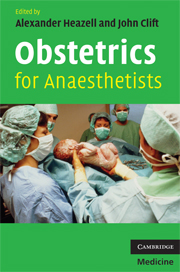Book contents
- Frontmatter
- Contents
- List of contributors
- Foreword
- Preface
- Acknowledgements
- List of abbreviations
- 1 Maternal physiology and obstetrics
- 2 Antenatal care
- 3 Induction of labour
- 4 Normal labour
- 5 Abnormal labour
- 6 Fetal monitoring
- 7 Pre-eclampsia and hypertensive disorders of pregnancy
- 8 Operative obstetrics
- 9 Obstetric haemorrhage
- 10 Thromboembolic disorders of pregnancy
- 11 Infection
- 12 Life support in obstetrics
- 13 Drugs in obstetrics
- 14 Confidential enquiries into fetal, neonatal and maternal death
- Appendix 1 Adult Advanced Life Support Algorithm
- Appendix 2 The Management of Postpartum Haemorrhage Algorithm
- Appendix 3 Emergency Management of Eclamptic Fit Algorithm
- Index
- References
13 - Drugs in obstetrics
Published online by Cambridge University Press: 21 August 2009
- Frontmatter
- Contents
- List of contributors
- Foreword
- Preface
- Acknowledgements
- List of abbreviations
- 1 Maternal physiology and obstetrics
- 2 Antenatal care
- 3 Induction of labour
- 4 Normal labour
- 5 Abnormal labour
- 6 Fetal monitoring
- 7 Pre-eclampsia and hypertensive disorders of pregnancy
- 8 Operative obstetrics
- 9 Obstetric haemorrhage
- 10 Thromboembolic disorders of pregnancy
- 11 Infection
- 12 Life support in obstetrics
- 13 Drugs in obstetrics
- 14 Confidential enquiries into fetal, neonatal and maternal death
- Appendix 1 Adult Advanced Life Support Algorithm
- Appendix 2 The Management of Postpartum Haemorrhage Algorithm
- Appendix 3 Emergency Management of Eclamptic Fit Algorithm
- Index
- References
Summary
Introduction
Drugs used in obstetrics merit special mention because they have their effects on two patients rather than one. Pharmacologically they are of particular interest because they may be transferred across, and metabolised by, another organ, the placenta. It is important for the anaesthetist to have an understanding of the drugs commonly used by obstetricians, the evidence for them and their interface with anaesthetics.
Drugs to increase uterine contractions
Indications
Acceleration/augmentation of labour
To minimise risk of postpartum haemorrhage (PPH)
Treatment of PPH
Oxytocin
In the UK a synthetic oxytocin is manufactured under the name syntocinion. It is a nonapeptide used to induce and augment labour and also to minimise blood loss post-delivery.
It is thought to act by binding to myometrial cell receptors and increasing smooth muscle contractility.
Guidelines from the Royal College of Obstetricians and Gynaecologists recommend that to induce or accelerate labour, oxytocin is given intravenously starting at a rate of 1–2 miU/min, titrated to uterine contractions and increasing every 30 minutes to a maximum of 32 miU/min.
It may also be given as a dose of 5 units slowly after delivery of baby during Caesarean section.
Can be given as an infusion of 10 U/hr for the treatment prevention of PPH secondary to uterine atony. This is normally for a period of 4 hours.
Its main adverse effect is the relaxation of vascular smooth muscle causing hypotension and a reflex tachycardia: this is potentiated in vasoconstricted states such as pre-eclampsia and hypovolaemia. It also has an antidiuretic effect, which can lead to water intoxication in large doses. Other side effects include nausea, vomiting and rashes.
Keywords
- Type
- Chapter
- Information
- Obstetrics for Anaesthetists , pp. 140 - 148Publisher: Cambridge University PressPrint publication year: 2008



